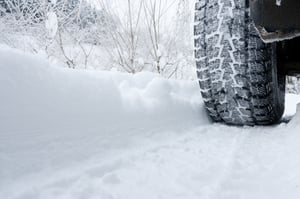 If you dislike winter driving, or worse, it creates significant anxiety whenever you hear a big snowstorm is about to hit, you’re not alone. Every winter, the first snowfall causes many accidents. Drivers forget what it takes to navigate slippery, snow covered roads safely. Different driving skills are needed to stay accident free during the winter months.
If you dislike winter driving, or worse, it creates significant anxiety whenever you hear a big snowstorm is about to hit, you’re not alone. Every winter, the first snowfall causes many accidents. Drivers forget what it takes to navigate slippery, snow covered roads safely. Different driving skills are needed to stay accident free during the winter months.
If you’re fortunate to drive a vehicle with four wheel or all-wheel drive, your confidence level is probably a bit better than people driving regular front wheel drive cars. However, these vehicles aren’t invincible.
If you’re a commuter or dislike driving in the snow, winter tires are for you! Before you run out the door to purchase yours, here’s some helpful information to help you understand the features and benefits of winter tires as well as the process.
What are all-season tires?
All-season tires are standard equipment put on cars when they’re manufactured. These tires provide several benefits, such as a quiet, comfortable ride and decent tread life. They also offer year-round performance for whatever Mother Nature sends your way. They perform best in climates that don’t get significant yearly snowfalls. Keeping your all-season tires in good shape is essential to keeping you and your family safe. Click here to learn more about keeping your tires in good condition.
What are winter tires and how are they different from all-season tires?
Again, winter driving presents many different challenges. Heavy snowfall, black ice, freezing rain, and blowing and drifting snow can instantly change the roadway. Winter tires have unique features that allow them to perform significantly better than all-season tires. Here are some things that make them different.
- Provide more flexibility. Frigid temperatures cause the tread rubber on all-season tires to harden, reducing their ability to grip the road. Winter tires are more flexible allowing them more grip.
- Offer exceptional traction. Different tread designs allow them to push snow outward avoiding snow buildup. While many people believe all-wheel or four-wheel drive is necessary to survive winter, winter tires hold their own and are a cheaper alternative.
- Offer better steering and braking. The flexibility and softness of winter tires create better grip which prevents the tires from sliding over a slippery surface.
- Reduce hydroplaning. Hydroplaning is a function of speed, inadequate tire tread, and standing water. Hydroplaning occurs when water on the road causes your tires to lose contact with the road. For tips to avoid hydroplaning, click here.
When should you put winter tires on?
Winter tires can be put on in mid-November and removed in mid-March or early April. Winter tires are not manufactured year-round. Depending on the tires you pick, they may only be available for a limited time.
How long do winter tires last?
On average, Americans drive 13,476 miles per year which equals 1,123 miles per month. If you use your winter tires for four months per year, a 40,000-mile tire will last approximately eight to nine years. Remember that winter tires will take some of the wear and tear off your all-season tires so they’ll last longer.
How much do they cost?
Tires are a critical component of our car that is often neglected until something goes wrong. Buying tires is usually not fun and can get expensive. So, the thought of purchasing an extra set of tires may seem overwhelming. However, I assure you that once you put winter tires on your car, you’ll ask yourself why you didn’t do it sooner. A good set of winter tires can cost up to $1,000. It'll be more if you want to buy specific rims for those tires. Remember that the rims are a one-time purchase that will last the life of your car.
Where can they be stored?
Winter tires need to be removed when spring returns. Warmer temperatures and dry pavement can cause them to wear down faster. Tires should be stored in a cool, dry place like a basement or a climate-controlled facility. Storing them in a regular garage or shed may damage them due to extreme heat and high humidity. If you don’t have enough floor space, rack systems can be used. Some systems can be mounted to your wall. Lastly, there may be tire storage facilities in your area. Check with your mechanic or car dealership.
Here are a few storage tips to remember.
- Always wash the tires after the winter season.
- Tires can be stored upright or stacked. For safety, don’t stack them too high.
- If they’re not mounted on permanent rims, don’t hang them on hooks.
- Store them in airtight bags to help keep the oils in the rubber.
- Avoid storing them near a furnace, water heater, or radiator.
Can winter tires be used on trucks, SUVs, and cars with four-wheel or all-wheel drive?
Yes. Four-wheel and all-wheel drive systems help a vehicle get started down the road. These systems don’t help with braking or steering. The braking distance for vehicles with winter tires is significantly better than for vehicles with all-season tires.
Ultimately, buying and managing winter tires is a commitment, but they’re worth it!
Do you have any suggestions or information you’d like to share? I’d love to hear from you. Please share them in the box below.
Sources:
https://www.autoblog.com/2012/12/20/the-time-to-buy-snow-tires-was-yesterday/
https://blog.tirerack.com/blog/aj-vest/when-to-put-on-winter-tires





